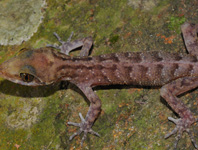Abstract
The Streaked Saltator, Saltator striatipectus, is an uncommon to common resident of open areas, cultivated land, gardens, and forest edges, with ten subspecies recognized from west Costa Rica through west Peru (Brewer 2016). Patterns of plumage variation, especially mantle color and streaking pattern below, are complex across subspecies and age classes (Chapman 1926; Ridgely & Tudor 2009; Brewer 2016). Until recently, S. striatipectus was considered conspecific with the Lesser Antillean Saltator S. albicollis, but separated on the basis of genetic differentiation despite overall plumage similarities (Seutin et al. 1993). Actually, S. striatipectus and S. albicollis are not each other’s closest relatives (Chaves et al. 2013).
References
Brewer, D. (2016) Streaked Saltator (Saltator striatipectus). In: del Hoyo, J., Elliott, A., Sargatal, J., Christie, D.A. & de Juana, E. (Eds.), Handbook of the Birds of the World Alive. Lynx Edicions, Barcelona. Available from: http://www.hbw.com/node/62209 (accessed 26 August 2016)
Chapman, F.M. (1926) The distribution of bird-life in Ecuador. A contribution to a study of the origin of Andean bird-life. Bulletin of the American Museum of Natural History, 25, 1–784.
Chaves, J.A., Hidalgo, J.R. & Klicka, J. (2013) Biogeography and evolutionary history of the Neotropical genus Saltator (Aves: Thraupini). Journal of Biogeography, 40, 2180–2190.
https://doi.org/10.1111/jbi.12150Clements, J.F., Schulenberg, T.S., Iliff, M.J., Roberson, D., Fredericks, T.A., Sullivan, B.L. & Wood, C.L. (2017) The eBird/Clements Checklist of Birds of the World: v2016. Cornell Lab of Ornithology, Ithaca. Available from: http://www.birds.cornell.edu/clementschecklist/download/ (accessed 22 November 2017)
Coates, A.G. & Obando, J.A. (1996) Geological evolution of the Central American isthmus. In: Jackson, J.B.C., Coates, A.G. & Budd, A. (Eds.), Evolution and Environment in Tropical America. University of Chicago Press, Chicago, pp. 21–56.
Deler, J.P., Gómez, N. & Portais, M. (1983) El Manejo del Espacio en el Ecuador. Etapas Claves. Tomo I. Geografía Histórica. Centro Ecuatoriano de Investigación Geográfica, Quito, 267 pp.
Hellmayr, C.E. (1938) Catalogue of Birds of the Americas. Vol. XIII. Part XI. Ploceidae-Catamblyrhynchidae-Fringillidae. Zoological Series. Field Museum of Natural History Publication 430. Field Museum of Natural History, Chicago, 662 pp.
Hoernle, K., van den Bogaard, P., Werner, R., Lissinna, B., Hauff, F., Alvarado, G. & Garbe-Schönberg, D. (2002) Missing history (16–71 Ma) of the Galápagos hotspot: implications for the tectonic and biological evolution of the Americas. Geology, 30 (9), 795–798.
https://doi.org/10.1130/0091-7613(2002)030<0795:MHMOTG>2.0.CO;2Kirby, M.X., Jones, D.S. & MacFadden, B.J. (2008) Lower Miocene stratigraphy along the Panama Canal and its bearing on the Central American Peninsula. PLoS ONE, 3 (7), e2791.
https://doi.org/10.1371/journal.pone.0002791Ridgely, R.S. & Greenfield, P.J. (2001a) The Birds of Ecuador. Volume II: Field Guide. Cornell University Press, Ithaca, 740 pp.
Ridgely, R.S. & Greenfield, P.J. (2001b) The Birds of Ecuador. Vol. I. Status, Distribution and Taxonomy. Cornell University Press, Ithaca, 848 pp.
Ridgely, R.S. & Tudor, G. (1989) The Birds of South America. Vol. I. Oscines. University of Texas Press, Austin, 516 pp.
Ridgely, R.S. & Tudor, G. (2009) Field Guide to the Songbirds of South America: Passerines. University of Texas Press, Austin, 750 pp.
Sclater, P.L. (1861) Characters of some new species of American Passeres. Proceedings of the Zoological Society of London, 1861, 127–131.
Seutin, G., Brawn, J., Ricklefs, R.E. & Bermingham, E. (1993) Genetic divergence among populations of a tropical passerine, the Streaked Saltator (Saltator albicollis). Auk, 110 (1), 117–126.

